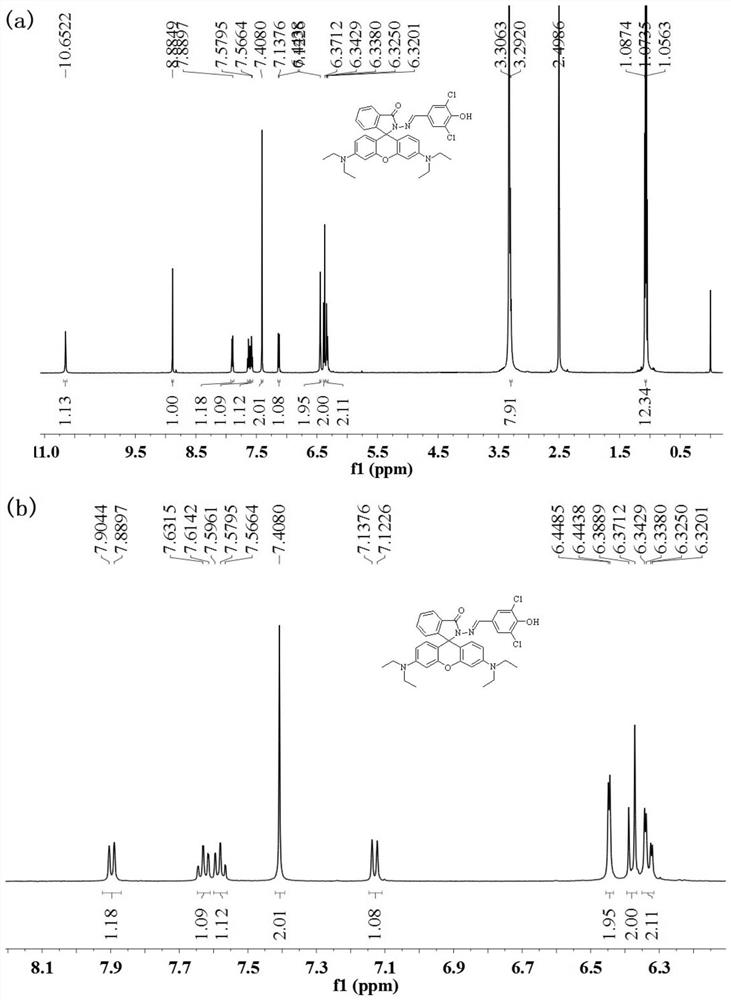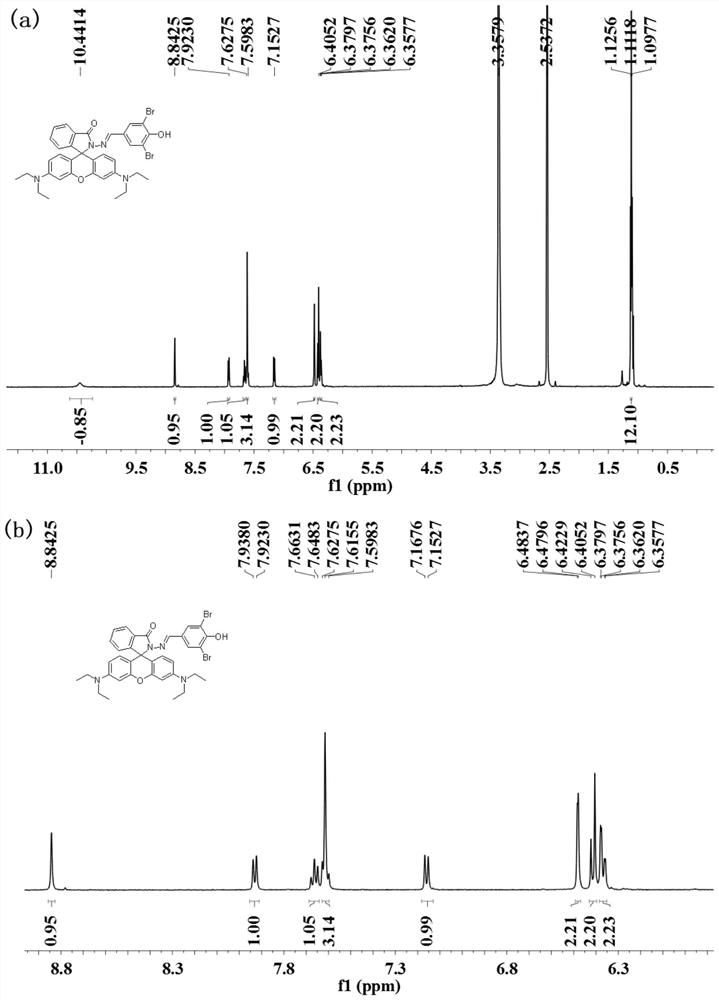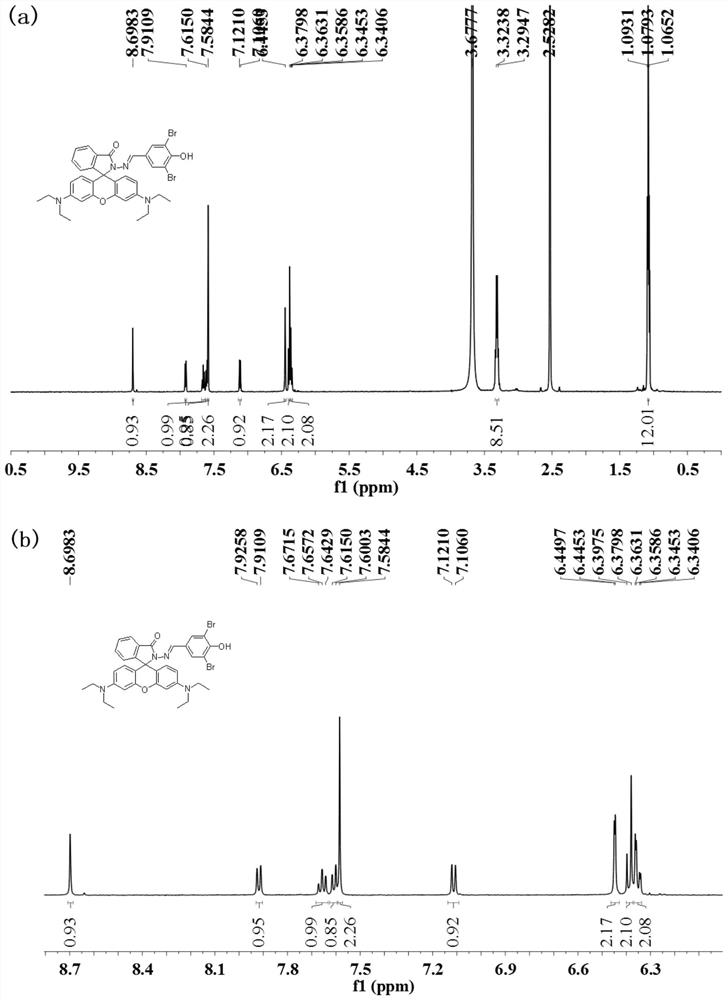Single-factor-initiated photochromic sensing material as well as preparation method and application thereof
A technology of photochromic and sensing materials, applied in the field of sensing materials, can solve the problems of application limitations, poor ion selectivity, loss of photochromism, etc., and achieve fast response, high sensitivity, and good stability
- Summary
- Abstract
- Description
- Claims
- Application Information
AI Technical Summary
Problems solved by technology
Method used
Image
Examples
no. 1 example
[0050] A preparation method of a photochromic sensing material, referring to reaction scheme 1, comprising the steps:
[0051] (1) Weigh rhodamine B hydrazide (0.456g, 1.0mmol), 3,5-dichloro-4-hydroxybenzaldehyde (0.191g, 1.0mmol) and 20mL of ethanol into a three-necked flask, reflux at 80°C React for 24 hours.
[0052] (2) after the described reflux reaction finishes, TLC monitoring reaction is complete, and the reaction solution is cooled to room temperature, and then part of the solvent and the reaction solution cooling crystallization are removed by rotary evaporation, and after suction filtration, a thick product is obtained, and the thick product is recrystallized with 5 mL of ethanol, The obtained pink solid is the photochromic sensing material A.
[0053]
[0054] The H NMR spectrum of the material A is as follows figure 1 (a), figure 1 As shown in (b), the structural characterization data of the product are as follows: 1 HNMR (500MHz, DMSO-d 6 ), δ(ppm): 10.65...
no. 2 example
[0057] A preparation method of a photochromic sensing material, referring to reaction scheme 1, comprising the steps:
[0058] (1) Weigh rhodamine B hydrazide (0.456g, 1.0mmol), 3,5-dibromo-4-hydroxybenzaldehyde (0.840g, 1.0mmol) and 20mL of ethanol into a three-necked flask, reflux at 80°C React for 24 hours.
[0059] (2) after the described reflux reaction finishes, TLC monitoring reaction is complete, and the reaction solution is cooled to room temperature, and then part of the solvent and the reaction solution cooling crystallization are removed by rotary evaporation, and after suction filtration, a thick product is obtained, and the thick product is recrystallized with 5 mL of ethanol, The obtained pink solid is the photochromic sensing material B.
[0060] The H NMR spectrum of the material B is as follows figure 2 (a), figure 2 As shown in (b), the structural characterization data of the product are as follows: 1 HNMR (500MHz, DMSO-d 6 ), δ(ppm): 10.44(s, 1H), 8....
no. 3 example
[0063] A preparation method of a photochromic sensing material, referring to reaction scheme 1, comprising the steps:
[0064] (1) Weigh rhodamine B hydrazide (0.456g, 1.0mmol), 3,5-dibromo-4-hydroxybenzaldehyde (0.840g, 3.0mmol) and 20mL of ethanol into a three-necked flask, reflux at 80°C React for 24 hours.
[0065] (2) after the described reflux reaction finishes, the reaction solution is cooled to room temperature, and the TLC monitoring reaction is complete, then rotary evaporation removes part of the solvent, the reaction solution is crystallized by cooling, and after suction filtration, a thick product is obtained, and the thick product is recrystallized with 5mL of ethanol, The obtained pink solid is the photochromic sensing material C.
[0066] The hydrogen nuclear magnetic resonance deuterium spectrum of the material C is as follows image 3 (a), image 3 As shown in (b), the structural characterization data of the product are as follows: 1 HNMR (500MHz, DMSO-d ...
PUM
 Login to View More
Login to View More Abstract
Description
Claims
Application Information
 Login to View More
Login to View More - R&D
- Intellectual Property
- Life Sciences
- Materials
- Tech Scout
- Unparalleled Data Quality
- Higher Quality Content
- 60% Fewer Hallucinations
Browse by: Latest US Patents, China's latest patents, Technical Efficacy Thesaurus, Application Domain, Technology Topic, Popular Technical Reports.
© 2025 PatSnap. All rights reserved.Legal|Privacy policy|Modern Slavery Act Transparency Statement|Sitemap|About US| Contact US: help@patsnap.com



